| The
Art of Being Boring
by Michael Bastin
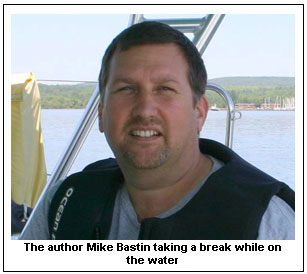 “Make
it look boring and you’ll be doing it right!”
These were the words of Captain Steve Burns, sailing
instructor and guru, to me and two other students
at the beginning of our Cruising Catamaran class
recently. This was to become our mantra during
the following days and proved to be words to take
to heart as I was to find out “Make
it look boring and you’ll be doing it right!”
These were the words of Captain Steve Burns, sailing
instructor and guru, to me and two other students
at the beginning of our Cruising Catamaran class
recently. This was to become our mantra during
the following days and proved to be words to take
to heart as I was to find out
How did this all start? Well,
like most sailors I have always dreamt of a bigger
better boat, and like many I ultimately want to
go offshore in that boat and explore far flung
exotic locations. Anyway, things were starting
to look good, the day was getting closer, and
suddenly twin daughters arrived on the scene.
This, as you can imagine, tends to change one’s
perspective just a little.
Monohulls, while being a lot
of fun, aren’t really suited to two precocious
4 year olds! Next step was to look at the alternative,
a vessel with more than one hull. Oh, I had heard
all the horror stories of catamarans capsizing
in open water and not being recoverable, and how
they can’t sail to windward, can’t
tack, get blown around a lot, and tend to break
in half due to the pressures being applied to
the bridge decks. But if this was all still true
then why were the charter companies getting more
and more of them, and why weren’t they all
sinking while being delivered to their exotic
new homes?
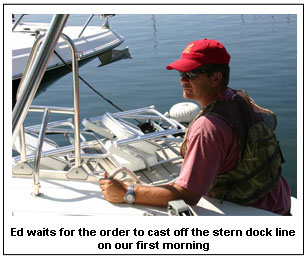 I
needed to find out and so I did my research. It
turns out that they are just as safe for open
water as monohulls and all the urban legends about
them are based on small hobie style catamarans
or larger mostly homebuilt vessels constructed
halfway through last century! These issues are
not really relevant to the modern breed of cruising
catamaran. Of course the newer catamarans do need
to be sailed a little differently, reefed earlier,
and are harder to find slips for than most monohulls
but the benefits more than balance up for the
disadvantages. I
needed to find out and so I did my research. It
turns out that they are just as safe for open
water as monohulls and all the urban legends about
them are based on small hobie style catamarans
or larger mostly homebuilt vessels constructed
halfway through last century! These issues are
not really relevant to the modern breed of cruising
catamaran. Of course the newer catamarans do need
to be sailed a little differently, reefed earlier,
and are harder to find slips for than most monohulls
but the benefits more than balance up for the
disadvantages.
So what was the next step? Simple,
book a charter in the BVI and take the kids and
another family down there to see what it was like
sailing a catamaran with small children.
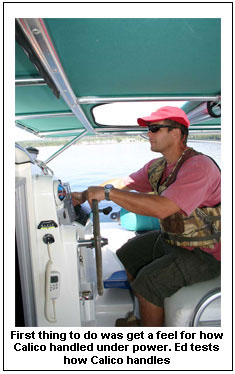 The
only problem was that I had never sailed a large
catamaran before and knew from reading that they
required some different skills to sail and handle.
Since my wife was the only other person going
on the trip with sailing experience it made sense
to increase our knowledge and skill level and
that meant taking a class. The
only problem was that I had never sailed a large
catamaran before and knew from reading that they
required some different skills to sail and handle.
Since my wife was the only other person going
on the trip with sailing experience it made sense
to increase our knowledge and skill level and
that meant taking a class.
Being in Minnesota the obvious
choice was Northern Breezes Sailing School, an
ASA certified school that offers a large selection
of sailing classes in both Minnesota and the BVI.
I contacted Thom Burns, the schools owner, and
secured a place in the July class. The class ran
from Monday to Wednesday out of Bayfield, WI on
Lake Superior and we were able to pre-board on
Sunday night.
Since the point of the class
was to learn how to handle a large cruising catamaran
we were to spend each night in the marina with
easy access to restaurants, and shore facilities.
On the Sunday evening I arrived at Steve Burn’s
Fountaine Pajot Athena 38 “Calico”
to find him just finishing up washing it and after
a quick and friendly hello he directed me to pick
a cabin and stow my gear. Calico’s slip
is the first one on the dock and is only a bit
wider than she is, with a finger pier on the seaward
side and a long steel wall on the landward side.
It is one of those slips that cause problems for
even the most skilled helmsman and there were
many gouges and marks on the steel wall from previous
boats that had tried to use it. My first thought
was that I hoped he wouldn’t want us to
try to bring her in and out of it! Not much later
Dave Bryant, a retired airline pilot, turned up.
It quickly turned out that he too had a charter
in the BVI booked for later in the year and wanted
to gain some insights into handling a catamaran
before heading down there with his family. Ed
Nelson, a St. Paul fire fighter, was to be the
third student and he arrived late Sunday night
after the rest of us had turned in. I was impressed
that I had not felt or heard anything when he
arrived and brought his gear on board. I doubt
whether the same would have been said if we had
all been on a 38 foot monohull.
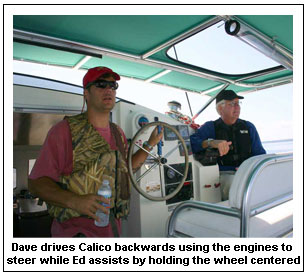 Dock
time, or start of class, was at 0900. Before then
we had already made Ed’s acquaintance and
determined that he had been chartering in the
BVI and seen the space on the catamarans and wanted
to charter down there again but on a catamaran
this time. Thus the theme was set. For the next
three days conversation both during class and
outside of it focused on cruising catamarans and
the BVI. Since Steve was very well versed in both
subjects, having been going to the BVI for some
twenty odd years, his opinions and insider information
were greatly appreciated by all. Dock
time, or start of class, was at 0900. Before then
we had already made Ed’s acquaintance and
determined that he had been chartering in the
BVI and seen the space on the catamarans and wanted
to charter down there again but on a catamaran
this time. Thus the theme was set. For the next
three days conversation both during class and
outside of it focused on cruising catamarans and
the BVI. Since Steve was very well versed in both
subjects, having been going to the BVI for some
twenty odd years, his opinions and insider information
were greatly appreciated by all.
Luckily for us Steve was not
only very knowledgeable and highly skilled; he
was also a very calm and patient instructor. His
credo, “It has to look boring!” was
obviously taken to heart by him in his teaching
style as well as being passed on to us. For our
part, as his students, we weren’t to run
or look hurried, and definitely no panicking,
but to slow everything down. I realized early
on that this wasn’t just a look cool gimmick
to impress the locals even if that was the obvious
result; it actually made learning easier and stopped
us from overreacting to what was happening with
the boat.
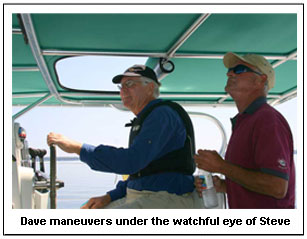 Steve
started out the class with a walkthrough of the
boat and then it was time to disconnect shore
power and remove the lazy dock lines in preparation
to get under way. The twin diesels had been quietly
gurgling and warming up the whole time and after
a quick check on the wind direction and strength
he had us cast off the remaining two dock lines
and he eased Calico out in reverse, paralleling
the evil steel wall with ease, spun her on the
spot and headed out towards open water. He made
it look exceedingly easy and I have to admit quite
boring. Steve
started out the class with a walkthrough of the
boat and then it was time to disconnect shore
power and remove the lazy dock lines in preparation
to get under way. The twin diesels had been quietly
gurgling and warming up the whole time and after
a quick check on the wind direction and strength
he had us cast off the remaining two dock lines
and he eased Calico out in reverse, paralleling
the evil steel wall with ease, spun her on the
spot and headed out towards open water. He made
it look exceedingly easy and I have to admit quite
boring.
That was the last time that Steve
took the wheel and signaled the commencement of
our on the water training. The actual part that
we had all been looking forward to and dreading,
taking turns as the nominated skipper and helmsman.
Handling dock lines and running rigging held no
real fear for any of us as we were all well acquainted
with sailboats in general but being on the helm
we could really screw up. But then again, that’s
what we were there for, to learn now so we wouldn’t
screw up when we were on our own with family members
at stake.
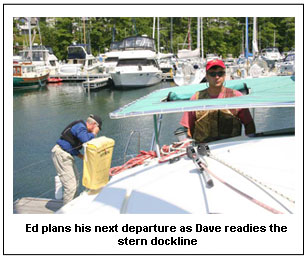 We
quickly fell into an order that remained pretty
much constant for the 3 days with Ed going first,
Dave second and me bringing up the tail. First
off we all had to learn how Calico handled under
power. Holding the wheel centered and using various
combinations of forward and reverse on the port
and starboard engines we did wide turns, close
turns, spun on the spot, drove forward in a straight
line and finally backed the boat up a couple of
hundred yards in a straight line. I though we
all did a great job and I was particularly proud
of my reversing abilities until I managed to forget
to hold the wheel centered and the rudders flipped
full to one side resulting in a loud bang and
red face. To make things worse, it was at this
point that Steve very diplomatically pointed out
that I was not in fact reversing to where I thought
I was. In fact we were all suffering from a perception
error to some degree or other while going in forward
and reverse; it was just more obvious in reverse.
With all of us being used to the centralized helm
position of most monohulls the offset helm of
the big cat resulted in us pointing the boat 5
to 10 degrees off from where we wanted to go.
Once we were made aware of this we adjusted our
sight lines and it became much easier to go straight. We
quickly fell into an order that remained pretty
much constant for the 3 days with Ed going first,
Dave second and me bringing up the tail. First
off we all had to learn how Calico handled under
power. Holding the wheel centered and using various
combinations of forward and reverse on the port
and starboard engines we did wide turns, close
turns, spun on the spot, drove forward in a straight
line and finally backed the boat up a couple of
hundred yards in a straight line. I though we
all did a great job and I was particularly proud
of my reversing abilities until I managed to forget
to hold the wheel centered and the rudders flipped
full to one side resulting in a loud bang and
red face. To make things worse, it was at this
point that Steve very diplomatically pointed out
that I was not in fact reversing to where I thought
I was. In fact we were all suffering from a perception
error to some degree or other while going in forward
and reverse; it was just more obvious in reverse.
With all of us being used to the centralized helm
position of most monohulls the offset helm of
the big cat resulted in us pointing the boat 5
to 10 degrees off from where we wanted to go.
Once we were made aware of this we adjusted our
sight lines and it became much easier to go straight.
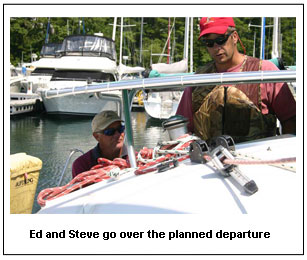 Once
we had the feel for how to drive Calico it was
time to head back into the marina and put it into
practice. Fenders were deployed and bow and sterns
lines attached to the starboard side and a single
line handler was nominated. Initially Steve was
going to have both off-helm students act as line
handlers but then decided it was in our best interests
to learn how to arrive and depart from a dock
with a single line handler. His very valid reasoning
was that this was the way we would be doing it
most often in real life. This worked out well
for us as it not only proved that we could do
it easily with a single handler but also allowed
the third student to learn through observing the
other students at work. We all had the opportunity
to do a couple of nose-in dockings and the time
just flew by, before we knew it, it was time for
a late lunch. Once
we had the feel for how to drive Calico it was
time to head back into the marina and put it into
practice. Fenders were deployed and bow and sterns
lines attached to the starboard side and a single
line handler was nominated. Initially Steve was
going to have both off-helm students act as line
handlers but then decided it was in our best interests
to learn how to arrive and depart from a dock
with a single line handler. His very valid reasoning
was that this was the way we would be doing it
most often in real life. This worked out well
for us as it not only proved that we could do
it easily with a single handler but also allowed
the third student to learn through observing the
other students at work. We all had the opportunity
to do a couple of nose-in dockings and the time
just flew by, before we knew it, it was time for
a late lunch.
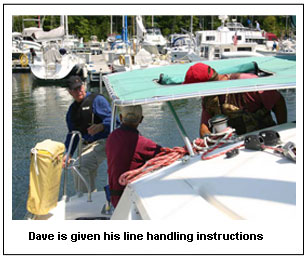 During
the morning the wind had been almost non existent
but after eating it had started to pick up a bit
and so we headed back out of the marina and hoisted
the mainsail. I think we were all a little surprised
at just how much effort was required to get the
large sail raised. Once it was up it was back
into the cavernous cockpit to unfurl the genoa
and away we went. The cat made easy work of it
even in light air and the feeling of non-heeling
was delightful. Steve ran us all through tacking
and jibing drills, especially re-enforcing the
differences in sail handling between monohulls
and catamarans. These included such tactics as
delaying the release of the genoa until the nose
was through the wind, and easing the boom across
using the helm while jibing. The one thing I did
miss was the feedback through the wheel that I
was used to on a monohull. During
the morning the wind had been almost non existent
but after eating it had started to pick up a bit
and so we headed back out of the marina and hoisted
the mainsail. I think we were all a little surprised
at just how much effort was required to get the
large sail raised. Once it was up it was back
into the cavernous cockpit to unfurl the genoa
and away we went. The cat made easy work of it
even in light air and the feeling of non-heeling
was delightful. Steve ran us all through tacking
and jibing drills, especially re-enforcing the
differences in sail handling between monohulls
and catamarans. These included such tactics as
delaying the release of the genoa until the nose
was through the wind, and easing the boom across
using the helm while jibing. The one thing I did
miss was the feedback through the wheel that I
was used to on a monohull.
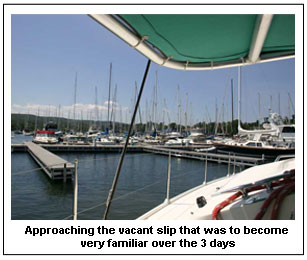 After
a fun afternoon of sailing it was time to head
back in and since Dave was on the helm, Ed and
I lowered and secured the sails before setting
the boat up for docking. As we came past the fuel
dock I could almost hear Dave’s heart miss
a beat as Steve nonchalantly told him that he
could take Calico into its difficult slip. To
give Dave credit though, even with a shifting
crosswind he did a perfect job. Steve later commented
that he normally doesn’t let students do
that on the first day but he was impressed by
how well we were all doing. After
a fun afternoon of sailing it was time to head
back in and since Dave was on the helm, Ed and
I lowered and secured the sails before setting
the boat up for docking. As we came past the fuel
dock I could almost hear Dave’s heart miss
a beat as Steve nonchalantly told him that he
could take Calico into its difficult slip. To
give Dave credit though, even with a shifting
crosswind he did a perfect job. Steve later commented
that he normally doesn’t let students do
that on the first day but he was impressed by
how well we were all doing.
“Calico”
With Calico secured snugly back
into her slip it was time for dinner, refreshments,
and recaps of the day’s events as well as
more talk of the BVI. Since we had the written
exam next morning we all took the opportunity
to retire fairly early and hit the books.
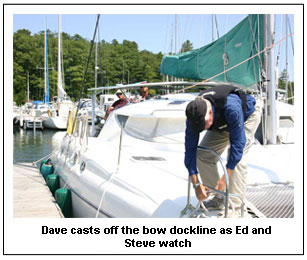 Tuesday
dawned bright and clear with no wind again so
at 9 AM as planned we all trudged up the hill
to beautiful Pike’s Bay Marina clubhouse
and sat for the exam. As it turned out it wasn’t
as hard as we had all feared it would be and we
all passed easily. It was nice to have it out
of the way so we could get back to the serious
business of learning how to handle the boat. Tuesday
dawned bright and clear with no wind again so
at 9 AM as planned we all trudged up the hill
to beautiful Pike’s Bay Marina clubhouse
and sat for the exam. As it turned out it wasn’t
as hard as we had all feared it would be and we
all passed easily. It was nice to have it out
of the way so we could get back to the serious
business of learning how to handle the boat.
The wind was finally picking
up, still light but at least we could get the
sails up. This time we went through the figure
8 and quick turn man overboard drills under sail
and never missed our man. Well almost never! I
managed to throw the type IV PFD we were using
as our “man overboard” in with the
straps down and was unable to hook the straps
easily to complete the recovery. Steve decided
to make the most of it and had Dave (who was on
the helm) initiate a new man overboard drill twice
more before I finally retrieved the cushion. Dave
took it very well and still talked to me after
I promised to buy first round that night.
 The
wind was dying, it was time to practice anchoring
drills so we secured the sails and motored to
nearby Long Island. Since it was my turn on the
helm I brought her into the wind and held her
in one spot in 12 feet of water. Meanwhile Steve
had Dave and Ed up on the foredeck deploying the
anchor and signaling instructions back to me.
With twin diesels it was fairly easy to hold her
steady and gently back her down. Calico’s
has an all chain rode and her anchor set easily
on the first go and after shutting down the engines
we all got together on the foredeck to recap.
When the flies started swarming us from the island
it was time to go. After weighing anchor the wind
had finally decided to play the game and we once
again hoisted sails and checked out a couple of
the lighthouses on the island before going onto
a broad reach for the run home. This was to be
the best sailing we saw over the three days. The
wind was dying, it was time to practice anchoring
drills so we secured the sails and motored to
nearby Long Island. Since it was my turn on the
helm I brought her into the wind and held her
in one spot in 12 feet of water. Meanwhile Steve
had Dave and Ed up on the foredeck deploying the
anchor and signaling instructions back to me.
With twin diesels it was fairly easy to hold her
steady and gently back her down. Calico’s
has an all chain rode and her anchor set easily
on the first go and after shutting down the engines
we all got together on the foredeck to recap.
When the flies started swarming us from the island
it was time to go. After weighing anchor the wind
had finally decided to play the game and we once
again hoisted sails and checked out a couple of
the lighthouses on the island before going onto
a broad reach for the run home. This was to be
the best sailing we saw over the three days.
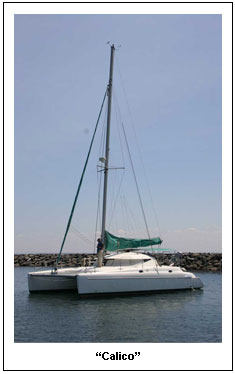 Maneuvering
under power was the order of the day again. This
time it was a backwards day with plenty of practice
reversing into slips. To make it more interesting
Steve would have us drive out of the slip and
down the fairway. Bringing the boat to a full
stop we would then pivot her around 360 degrees
before backing all the way back to the slip and
docking her in reverse. Maneuvering
under power was the order of the day again. This
time it was a backwards day with plenty of practice
reversing into slips. To make it more interesting
Steve would have us drive out of the slip and
down the fairway. Bringing the boat to a full
stop we would then pivot her around 360 degrees
before backing all the way back to the slip and
docking her in reverse.
Once we had all had plenty of
practice at this and felt like capable old hands
we headed back out onto the lake to practice the
Power Squadron man overboard procedure. None of
us had ever seen this before and it relied on
the crew calling out the side over which the crewmember
had fallen while calling man overboard. The helmsman
would then respond by turning hard to that side
to get the props away from the person in the water
before circling back around to pick up the crew
member. We all agreed that this was a very valuable
addition to our skill sets.
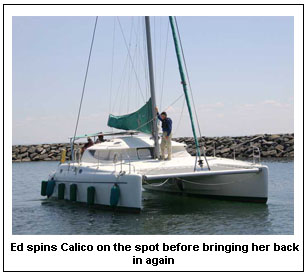 Since
we had covered all the material in the class and
still had some time left Steve asked us what we
would like to finish up with and we voted for
a visit to the Madeline Island marina. I was fortunate
enough to be on the helm again and as we arrived
Steve had me bring Calico in through the channel
and spin her in front of the fuel dock. One of
the staff came out and offered to help us but
we politely thanked her and said that we were
fine. I then brought the boat up to the visitors’
docks and with a fair crosswind reversed her in.
Once the stern was secured a bit of forward power
and the bow was tied off. We had arrived without
any trauma and hardly any words spoken. The staff
member from the marina came up and said “You
guys sure make it look easy!” This was the
highlight of my week! Of course, I was sweating
profusely and still had copious amounts of adrenaline
coursing through my system but I wasn’t
about to tell her that, a simple thanks would
suffice. To me, this meant that the class had
done what it was supposed to and had been worth
it. We had looked boring to her and that’s
what it was all about. Since
we had covered all the material in the class and
still had some time left Steve asked us what we
would like to finish up with and we voted for
a visit to the Madeline Island marina. I was fortunate
enough to be on the helm again and as we arrived
Steve had me bring Calico in through the channel
and spin her in front of the fuel dock. One of
the staff came out and offered to help us but
we politely thanked her and said that we were
fine. I then brought the boat up to the visitors’
docks and with a fair crosswind reversed her in.
Once the stern was secured a bit of forward power
and the bow was tied off. We had arrived without
any trauma and hardly any words spoken. The staff
member from the marina came up and said “You
guys sure make it look easy!” This was the
highlight of my week! Of course, I was sweating
profusely and still had copious amounts of adrenaline
coursing through my system but I wasn’t
about to tell her that, a simple thanks would
suffice. To me, this meant that the class had
done what it was supposed to and had been worth
it. We had looked boring to her and that’s
what it was all about.
So all I have to say now is
“Bring on the BVI, and let’s make
it boring!”
Michael Bastin is from Australia.
Initially coming to the USA to be a sailing instructor
and sailing director at YMCA Camp St. Croix in
Hudson, WI. He is now an ASA Instructor for Northern
Breezes Sailing School, and a freelance writer
living in Minneapolis, MN.
TOP
|

 “Make
it look boring and you’ll be doing it right!”
These were the words of Captain Steve Burns, sailing
instructor and guru, to me and two other students
at the beginning of our Cruising Catamaran class
recently. This was to become our mantra during
the following days and proved to be words to take
to heart as I was to find out
“Make
it look boring and you’ll be doing it right!”
These were the words of Captain Steve Burns, sailing
instructor and guru, to me and two other students
at the beginning of our Cruising Catamaran class
recently. This was to become our mantra during
the following days and proved to be words to take
to heart as I was to find out I
needed to find out and so I did my research. It
turns out that they are just as safe for open
water as monohulls and all the urban legends about
them are based on small hobie style catamarans
or larger mostly homebuilt vessels constructed
halfway through last century! These issues are
not really relevant to the modern breed of cruising
catamaran. Of course the newer catamarans do need
to be sailed a little differently, reefed earlier,
and are harder to find slips for than most monohulls
but the benefits more than balance up for the
disadvantages.
I
needed to find out and so I did my research. It
turns out that they are just as safe for open
water as monohulls and all the urban legends about
them are based on small hobie style catamarans
or larger mostly homebuilt vessels constructed
halfway through last century! These issues are
not really relevant to the modern breed of cruising
catamaran. Of course the newer catamarans do need
to be sailed a little differently, reefed earlier,
and are harder to find slips for than most monohulls
but the benefits more than balance up for the
disadvantages.  The
only problem was that I had never sailed a large
catamaran before and knew from reading that they
required some different skills to sail and handle.
Since my wife was the only other person going
on the trip with sailing experience it made sense
to increase our knowledge and skill level and
that meant taking a class.
The
only problem was that I had never sailed a large
catamaran before and knew from reading that they
required some different skills to sail and handle.
Since my wife was the only other person going
on the trip with sailing experience it made sense
to increase our knowledge and skill level and
that meant taking a class.  Dock
time, or start of class, was at 0900. Before then
we had already made Ed’s acquaintance and
determined that he had been chartering in the
BVI and seen the space on the catamarans and wanted
to charter down there again but on a catamaran
this time. Thus the theme was set. For the next
three days conversation both during class and
outside of it focused on cruising catamarans and
the BVI. Since Steve was very well versed in both
subjects, having been going to the BVI for some
twenty odd years, his opinions and insider information
were greatly appreciated by all.
Dock
time, or start of class, was at 0900. Before then
we had already made Ed’s acquaintance and
determined that he had been chartering in the
BVI and seen the space on the catamarans and wanted
to charter down there again but on a catamaran
this time. Thus the theme was set. For the next
three days conversation both during class and
outside of it focused on cruising catamarans and
the BVI. Since Steve was very well versed in both
subjects, having been going to the BVI for some
twenty odd years, his opinions and insider information
were greatly appreciated by all.  Steve
started out the class with a walkthrough of the
boat and then it was time to disconnect shore
power and remove the lazy dock lines in preparation
to get under way. The twin diesels had been quietly
gurgling and warming up the whole time and after
a quick check on the wind direction and strength
he had us cast off the remaining two dock lines
and he eased Calico out in reverse, paralleling
the evil steel wall with ease, spun her on the
spot and headed out towards open water. He made
it look exceedingly easy and I have to admit quite
boring.
Steve
started out the class with a walkthrough of the
boat and then it was time to disconnect shore
power and remove the lazy dock lines in preparation
to get under way. The twin diesels had been quietly
gurgling and warming up the whole time and after
a quick check on the wind direction and strength
he had us cast off the remaining two dock lines
and he eased Calico out in reverse, paralleling
the evil steel wall with ease, spun her on the
spot and headed out towards open water. He made
it look exceedingly easy and I have to admit quite
boring.  We
quickly fell into an order that remained pretty
much constant for the 3 days with Ed going first,
Dave second and me bringing up the tail. First
off we all had to learn how Calico handled under
power. Holding the wheel centered and using various
combinations of forward and reverse on the port
and starboard engines we did wide turns, close
turns, spun on the spot, drove forward in a straight
line and finally backed the boat up a couple of
hundred yards in a straight line. I though we
all did a great job and I was particularly proud
of my reversing abilities until I managed to forget
to hold the wheel centered and the rudders flipped
full to one side resulting in a loud bang and
red face. To make things worse, it was at this
point that Steve very diplomatically pointed out
that I was not in fact reversing to where I thought
I was. In fact we were all suffering from a perception
error to some degree or other while going in forward
and reverse; it was just more obvious in reverse.
With all of us being used to the centralized helm
position of most monohulls the offset helm of
the big cat resulted in us pointing the boat 5
to 10 degrees off from where we wanted to go.
Once we were made aware of this we adjusted our
sight lines and it became much easier to go straight.
We
quickly fell into an order that remained pretty
much constant for the 3 days with Ed going first,
Dave second and me bringing up the tail. First
off we all had to learn how Calico handled under
power. Holding the wheel centered and using various
combinations of forward and reverse on the port
and starboard engines we did wide turns, close
turns, spun on the spot, drove forward in a straight
line and finally backed the boat up a couple of
hundred yards in a straight line. I though we
all did a great job and I was particularly proud
of my reversing abilities until I managed to forget
to hold the wheel centered and the rudders flipped
full to one side resulting in a loud bang and
red face. To make things worse, it was at this
point that Steve very diplomatically pointed out
that I was not in fact reversing to where I thought
I was. In fact we were all suffering from a perception
error to some degree or other while going in forward
and reverse; it was just more obvious in reverse.
With all of us being used to the centralized helm
position of most monohulls the offset helm of
the big cat resulted in us pointing the boat 5
to 10 degrees off from where we wanted to go.
Once we were made aware of this we adjusted our
sight lines and it became much easier to go straight.
 Once
we had the feel for how to drive Calico it was
time to head back into the marina and put it into
practice. Fenders were deployed and bow and sterns
lines attached to the starboard side and a single
line handler was nominated. Initially Steve was
going to have both off-helm students act as line
handlers but then decided it was in our best interests
to learn how to arrive and depart from a dock
with a single line handler. His very valid reasoning
was that this was the way we would be doing it
most often in real life. This worked out well
for us as it not only proved that we could do
it easily with a single handler but also allowed
the third student to learn through observing the
other students at work. We all had the opportunity
to do a couple of nose-in dockings and the time
just flew by, before we knew it, it was time for
a late lunch.
Once
we had the feel for how to drive Calico it was
time to head back into the marina and put it into
practice. Fenders were deployed and bow and sterns
lines attached to the starboard side and a single
line handler was nominated. Initially Steve was
going to have both off-helm students act as line
handlers but then decided it was in our best interests
to learn how to arrive and depart from a dock
with a single line handler. His very valid reasoning
was that this was the way we would be doing it
most often in real life. This worked out well
for us as it not only proved that we could do
it easily with a single handler but also allowed
the third student to learn through observing the
other students at work. We all had the opportunity
to do a couple of nose-in dockings and the time
just flew by, before we knew it, it was time for
a late lunch.  During
the morning the wind had been almost non existent
but after eating it had started to pick up a bit
and so we headed back out of the marina and hoisted
the mainsail. I think we were all a little surprised
at just how much effort was required to get the
large sail raised. Once it was up it was back
into the cavernous cockpit to unfurl the genoa
and away we went. The cat made easy work of it
even in light air and the feeling of non-heeling
was delightful. Steve ran us all through tacking
and jibing drills, especially re-enforcing the
differences in sail handling between monohulls
and catamarans. These included such tactics as
delaying the release of the genoa until the nose
was through the wind, and easing the boom across
using the helm while jibing. The one thing I did
miss was the feedback through the wheel that I
was used to on a monohull.
During
the morning the wind had been almost non existent
but after eating it had started to pick up a bit
and so we headed back out of the marina and hoisted
the mainsail. I think we were all a little surprised
at just how much effort was required to get the
large sail raised. Once it was up it was back
into the cavernous cockpit to unfurl the genoa
and away we went. The cat made easy work of it
even in light air and the feeling of non-heeling
was delightful. Steve ran us all through tacking
and jibing drills, especially re-enforcing the
differences in sail handling between monohulls
and catamarans. These included such tactics as
delaying the release of the genoa until the nose
was through the wind, and easing the boom across
using the helm while jibing. The one thing I did
miss was the feedback through the wheel that I
was used to on a monohull.  After
a fun afternoon of sailing it was time to head
back in and since Dave was on the helm, Ed and
I lowered and secured the sails before setting
the boat up for docking. As we came past the fuel
dock I could almost hear Dave’s heart miss
a beat as Steve nonchalantly told him that he
could take Calico into its difficult slip. To
give Dave credit though, even with a shifting
crosswind he did a perfect job. Steve later commented
that he normally doesn’t let students do
that on the first day but he was impressed by
how well we were all doing.
After
a fun afternoon of sailing it was time to head
back in and since Dave was on the helm, Ed and
I lowered and secured the sails before setting
the boat up for docking. As we came past the fuel
dock I could almost hear Dave’s heart miss
a beat as Steve nonchalantly told him that he
could take Calico into its difficult slip. To
give Dave credit though, even with a shifting
crosswind he did a perfect job. Steve later commented
that he normally doesn’t let students do
that on the first day but he was impressed by
how well we were all doing.  Tuesday
dawned bright and clear with no wind again so
at 9 AM as planned we all trudged up the hill
to beautiful Pike’s Bay Marina clubhouse
and sat for the exam. As it turned out it wasn’t
as hard as we had all feared it would be and we
all passed easily. It was nice to have it out
of the way so we could get back to the serious
business of learning how to handle the boat.
Tuesday
dawned bright and clear with no wind again so
at 9 AM as planned we all trudged up the hill
to beautiful Pike’s Bay Marina clubhouse
and sat for the exam. As it turned out it wasn’t
as hard as we had all feared it would be and we
all passed easily. It was nice to have it out
of the way so we could get back to the serious
business of learning how to handle the boat. The
wind was dying, it was time to practice anchoring
drills so we secured the sails and motored to
nearby Long Island. Since it was my turn on the
helm I brought her into the wind and held her
in one spot in 12 feet of water. Meanwhile Steve
had Dave and Ed up on the foredeck deploying the
anchor and signaling instructions back to me.
With twin diesels it was fairly easy to hold her
steady and gently back her down. Calico’s
has an all chain rode and her anchor set easily
on the first go and after shutting down the engines
we all got together on the foredeck to recap.
When the flies started swarming us from the island
it was time to go. After weighing anchor the wind
had finally decided to play the game and we once
again hoisted sails and checked out a couple of
the lighthouses on the island before going onto
a broad reach for the run home. This was to be
the best sailing we saw over the three days.
The
wind was dying, it was time to practice anchoring
drills so we secured the sails and motored to
nearby Long Island. Since it was my turn on the
helm I brought her into the wind and held her
in one spot in 12 feet of water. Meanwhile Steve
had Dave and Ed up on the foredeck deploying the
anchor and signaling instructions back to me.
With twin diesels it was fairly easy to hold her
steady and gently back her down. Calico’s
has an all chain rode and her anchor set easily
on the first go and after shutting down the engines
we all got together on the foredeck to recap.
When the flies started swarming us from the island
it was time to go. After weighing anchor the wind
had finally decided to play the game and we once
again hoisted sails and checked out a couple of
the lighthouses on the island before going onto
a broad reach for the run home. This was to be
the best sailing we saw over the three days. Maneuvering
under power was the order of the day again. This
time it was a backwards day with plenty of practice
reversing into slips. To make it more interesting
Steve would have us drive out of the slip and
down the fairway. Bringing the boat to a full
stop we would then pivot her around 360 degrees
before backing all the way back to the slip and
docking her in reverse.
Maneuvering
under power was the order of the day again. This
time it was a backwards day with plenty of practice
reversing into slips. To make it more interesting
Steve would have us drive out of the slip and
down the fairway. Bringing the boat to a full
stop we would then pivot her around 360 degrees
before backing all the way back to the slip and
docking her in reverse.  Since
we had covered all the material in the class and
still had some time left Steve asked us what we
would like to finish up with and we voted for
a visit to the Madeline Island marina. I was fortunate
enough to be on the helm again and as we arrived
Steve had me bring Calico in through the channel
and spin her in front of the fuel dock. One of
the staff came out and offered to help us but
we politely thanked her and said that we were
fine. I then brought the boat up to the visitors’
docks and with a fair crosswind reversed her in.
Once the stern was secured a bit of forward power
and the bow was tied off. We had arrived without
any trauma and hardly any words spoken. The staff
member from the marina came up and said “You
guys sure make it look easy!” This was the
highlight of my week! Of course, I was sweating
profusely and still had copious amounts of adrenaline
coursing through my system but I wasn’t
about to tell her that, a simple thanks would
suffice. To me, this meant that the class had
done what it was supposed to and had been worth
it. We had looked boring to her and that’s
what it was all about.
Since
we had covered all the material in the class and
still had some time left Steve asked us what we
would like to finish up with and we voted for
a visit to the Madeline Island marina. I was fortunate
enough to be on the helm again and as we arrived
Steve had me bring Calico in through the channel
and spin her in front of the fuel dock. One of
the staff came out and offered to help us but
we politely thanked her and said that we were
fine. I then brought the boat up to the visitors’
docks and with a fair crosswind reversed her in.
Once the stern was secured a bit of forward power
and the bow was tied off. We had arrived without
any trauma and hardly any words spoken. The staff
member from the marina came up and said “You
guys sure make it look easy!” This was the
highlight of my week! Of course, I was sweating
profusely and still had copious amounts of adrenaline
coursing through my system but I wasn’t
about to tell her that, a simple thanks would
suffice. To me, this meant that the class had
done what it was supposed to and had been worth
it. We had looked boring to her and that’s
what it was all about.